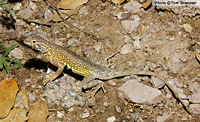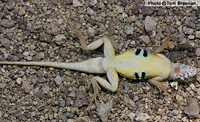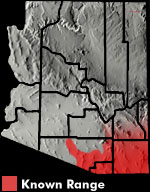Online Field Guide to The Reptiles and Amphibians of Arizona


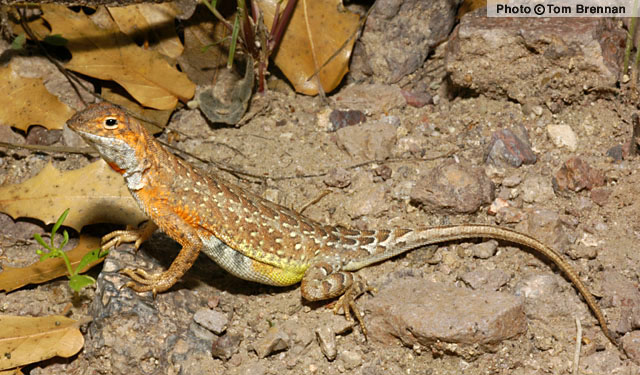
Gravid female. Santa Cruz County, AZ
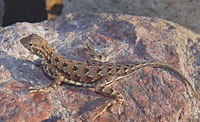 Female. Santa Cruz Co., AZ |
| ELEGANT EARLESS LIZARD Holbrookia elegans | |
|
DESCRIPTION: A small (up to 75 mm or 3″ from snout to vent), gray, tan, or orange-brown lizard with coloration that usually matches the substrate. Body markings usually consist of light speckles and four rows of brown blotches or chevrons extending from the neck to the tail. A row of chevrons runs down the top of the tail almost all the way to the tip. Some specimens lack dorsal markings. Two, sometimes three, dark bars mark each lower side of the body just behind the forelimb and a reddish orange patch marks the throat. Males have a yellow tint on the lower sides of the body, blue patches around black side bars, copious light speckling on the upper surfaces, and less distinct dorsal blotches. Side bars are usually light gray or absent on females. Gravid females have a pink or peach tint on the anterior body and a yellow tint on the posterior sides of the body. As its common name implies, this lizard lacks external ear openings. The scales are small and granular. The underside of the tail is plain white, distinguishing this lizard from the Greater Earless Lizard. Two bars (sometimes three) on each lower side and its lack of ear openings distinguish it from the Common Side-blotched Lizard. The similar Common Lesser Earless Lizard has a shorter tail, lacks chevrons on the posterior third of the tail, and is smaller than the Elegant Earless Lizard. DISTRIBUTION: This lizard is distributed across southeastern Arizona. Its boundary with the similar Common Lesser Earless Lizard to the north is poorly known. In Arizona the Elegant Earless Lizard is found at elevations ranging from about 2,200’ to over 6,500’. HABITAT: Primarily an inhabitant of Semidesert Grassland, grasslands, and open Madrean Evergreen Woodland. It also enters Sonoran Desertscrub and Chihuahuan Desertscrub communities in some localities. It is usually encountered on relatively level terrain in open, sunlit areas with sparse vegetation and loamy or gravelly soil. BEHAVIOR: This primarily diurnal lizard is most active mid morning and late afternoon, avoiding high mid-day temperatures. It is occasionally active on warm nights. It hibernates during the cold months of winter and late fall. DIET: The Elegant Earless Lizard feeds on a variety of insects, spiders, and small lizards. REPRODUCTION: Mating takes place in spring and one or two clutches of eggs are laid in spring and summer. By Thomas C. Brennan Brennan, T. C., & A. T. Holycross. 2006. A Field Guide to Amphibians and Reptiles in Arizona. Arizona Game and Fish Department. Phoenix, AZ Degenhardt, W. G., Painter, C. W., and Price, A. H.. 1996. Amphibians and Reptiles of New Mexico. University of New Mexico Press. Albuquerque. Stebbins, R.C. 2003. A Field Guide to Western Reptiles and Amphibians, Third Edition. Houghton Mifflin Company, Boston, MA. |
|
Visit Partners in Amphibian and Reptile Conservation:


HOME
Copyright © 2023, Arizona Game and Fish Department. All rights reserved.
If you make use of the textual contents of this site in reports, publications, etc. please cite and credit the author(s) and photographer(s). All photos on this website are copyrighted. However, those found in the species account section may be used for any noncommercial scientific, educational, or conservation purposes provided that photographs are not altered and continue to bear the copyright symbol and name of the photographer. Please contact the photographer regarding commercial use of copyrighted photographs.










